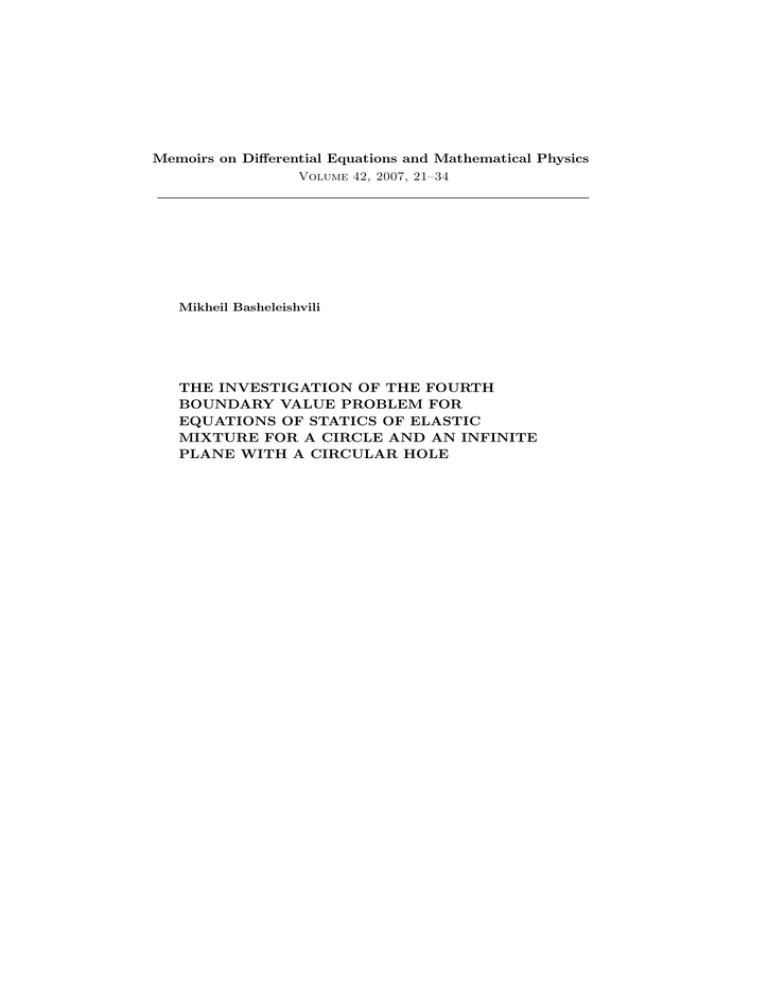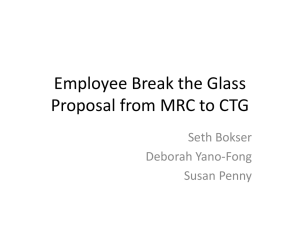Memoirs on Differential Equations and Mathematical Physics BOUNDARY VALUE PROBLEM FOR
advertisement

Memoirs on Differential Equations and Mathematical Physics Volume 42, 2007, 21–34 Mikheil Basheleishvili THE INVESTIGATION OF THE FOURTH BOUNDARY VALUE PROBLEM FOR EQUATIONS OF STATICS OF ELASTIC MIXTURE FOR A CIRCLE AND AN INFINITE PLANE WITH A CIRCULAR HOLE Abstract. The fourth boundary value problem for a circle and for an infinite domain with a circular hole is formulated. The theorem on the uniqueness of a solution is proved. Singular integral equations with Hilbert kernel are obtained for solving the problems. The formula of permutation of singular integrals with Hilbert kernel is used. The solutions of the abovementioned problems are represented in terms of the Poisson formula. 2000 Mathematics Subject Classification. 74B05. Key words and phrases. Singular integral equations with Hilbert kernel, potentials, Fredholm equations, Green’s formula. " ! " # The Investigation of the Fourth Boundary Value Problem 23 1. Statement of the Fourth Boundary Value Problem and the Uniqueness Theorems The system of the basic (homogeneous) equations of statics for an elastic mixture in two dimensions has the form ([1]) a1 ∆u0 + b1 grad div u0 + c∆u00 + d grad div u00 = 0, c∆u0 + d grad div u0 + a2 ∆u00 + b2 grad div u00 = 0, (1.1) where a1 = µ1 − λ5 , b1 = µ1 + λ1 − λ5 − ρ−1 α2 ρ2 , a2 = µ2 − λ5 , b2 = µ2 + λ1 + λ5 + ρ−1 α2 ρ2 , d = µ3 + λ3 − λ5 − ρ−1 α2 ρ1 ≡ µ3 + λ4 − λ5 + ρ−1 α2 ρ2 , (1.2) ρ = ρ 1 + ρ 2 , α2 = λ 3 − λ 4 . In (1.2), ρ1 and ρ2 are the partial densities, and µ1 , µ2 , µ3 , λ1 , λ2 , λ3 , λ4 , λ5 are real constants characterizing physical properties of an elastic mixture and satisfying certain inequalities. u0 = (u1 , u2 ) and u00 = (u3 , u4 ) are the partial displacements. If we introduce the variables z = x1 + ix2 , z = x1 − ix2 , i.e., z−z z+z , x2 = , 2 2i then the system (1.1) can be rewritten in the form ([2]) x1 = ∂2U ∂2U +K = 0, ∂z∂z ∂z 2 (1.3) where u1 + iu2 = mϕ(z) − Kmzϕ0 (z) + ψ(z), (1.4) u3 + iu4 l6 l5 l4 m1 m2 , m1 = l 1 + , m3 = l 3 + , m2 = l 2 + , M= m2 m3 2 2 2 a2 c a1 l1 = , l 2 = − , l 3 = , d2 d2 d2 c+d a1 + b 1 a2 + b 2 , l2 + l 5 = − , l3 + l 6 = , l1 + l 4 = d1 d1 d1 l k k3 , km = − , K= 1 (1.5) k2 k4 2 1 m3 −m2 l l , ∆0 = m1 m3 − m22 > 0, l = 4 5 , m−1 = l5 l6 ∆0 −m2 m1 U= δ0 k1 = 2(a2 b1 − cd) + b1 b2 − d2 , δ0 k2 = 2(da1 − cb1 ), δ0 k3 = 2(da2 − cb2 ), δ0 k4 = 2(a1 b2 − cd) + b1 b2 − d2 , 24 Mikheil Basheleishvili δ0 = (2a1 + b1 )(2a2 + b2 ) − (2c + d)2 ≡ 4d1 d2 ∆0 , δ1 = (a1 + b1 )(a2 + b2 ) − (c + d)2 > 0, d2 = a1 a2 − c2 > 0, ϕ(z) and ψ(z) are analytic vectors. The stress vector is of the form ∂ (T U )2 − i(T U )1 − 2ϕ(z) + 2µU , TU = = (T U )4 − i(T U )3 ∂s (1.6) where ∂ ∂ ∂ = n1 − n2 , (1.7) ∂s(x) ∂x2 ∂x1 n1 and n2 are the projections onto the axes x1 and x2 of the basis normal vector. It is evident that the basis tangent vector is s(x) = (−n2 , n1 ), and (T U )k is the projection of the stress vector onto the axes xk (k = 1, 4), µ µ3 (1.8) µ= 1 , det µ = µ1 µ2 − µ23 > 0. µ3 µ2 Here we present the definition of a regular solution ([3]). The vector U is a regular solution if it and its partial derivatives of the first order are continuous up to the boundary, while the second derivatives satisfy the system (1.3). We now can formulate the fourth boundary value problem: Find a regular solution in a circular domain D + which on the boundary (i.e. on the circumference of radius R) satisfies the boundary conditions (sU )+ = f (t), (nT U )+ = F (t), (1.9) where f and F are given continuous functions on the circumference. Here the sign “+” denotes limiting values from the inside. If instead of D + we have D− (i.e. an infinite plane with a hole), then the boundary conditions are (SU )− = f (t), (nT U )− = F (t), (1.10) where the sign “−” denotes limiting values from the outside. For the domain D− , to the regularity conditions we add the conditions at infinity: q ∂U = O(ρ−2 ), k = 1, 2, ρ = x21 + x22 . U = O(1), (1.11) ∂uk Thus we have the following formulas ([4]): Z Z Z (1.12) E(u, u) dy1 dy2 = uT u ds ≡ Im UT U ds, S D+ Z E(u, u) dy1 dy2 = − S Z uT u ds ≡ − Im S D− Z UT U ds, S where s is the circumference of radius R, Im UT U = 4 X k=1 uk (T U)k ≡ un (T U)n + us (T U)s , (1.13) 25 The Investigation of the Fourth Boundary Value Problem un , us , (T u)n , (T u)s are the normal and tangential components of the displacement and stress vectors, E(u, u) is the doubled potential energy of the form E(u, u) = ∂u 2 ∂u2 ∂u2 ∂u3 ∂u4 2 1 1 + + + + 2(d + λ5 ) + = (b1 − λ5 ) ∂x1 ∂x2 ∂x1 ∂x2 ∂x1 ∂x2 ∂u ∂u4 2 3 + +(b2 − λ5 ) + ∂x1 ∂x2 ∂u1 ∂u2 2 ∂u2 ∂u2 2 + +µ1 + − + ∂x1 ∂x2 ∂x1 ∂x2 ∂u1 ∂u2 ∂u3 ∂u4 ∂u2 ∂u1 ∂u4 ∂u3 +2µ3 + − − + + + ∂x1 ∂x2 ∂x1 ∂x2 ∂x1 ∂x2 ∂x1 ∂x2 ∂u3 ∂u4 2 ∂u4 ∂u3 2 +µ2 − + + − ∂x1 ∂x2 ∂x1 ∂x2 ∂u3 2 ∂u2 ∂u1 2 ∂u4 − − − . (1.14) −λ5 ∂x1 ∂x2 ∂x1 ∂x2 ∂u To solve the fourth boundary value problem, we prove the following Theorem. a regular solution in the domain D + satisfying the homogeneous conditions of the fourth boundary value problem is the identical zero, if s is not a straight line. Proof. The use is made here of the formula (1.12). If in (1.12) we have f = F = 0, then it follows from (1.14) that u1 = c1 − εx2 , u2 = c2 + εx1 , u3 = c3 − εx2 , u4 = c4 + εx1 , (1.15) where ck (k = 1, 4) and ε are arbitrary constants. Using now Green’s formula Z Z Z ∂u2 ∂u1 0 = (SU )+ ds = dx1 dx2 = 2εD, dx1 dx2 = 2ε − ∂x1 ∂x2 S D+ D+ where D is the space of the domain D + , we obtain ε = 0, and from (1.15) we get n 1 u2 − n 2 u1 = c 1 dx2 dx1 + c2 = 0 or finally, c2 x1 + c1 x2 = c, ds ds (1.16) where c is a constant. (1.16) is the equation of a straight line. Thus the theorem for the domain D + is complete. Let us now prove the uniqueness for the domain D − . Since (1.11) holds, therefore ε = 0, and from the condition (SU )− = 0 we obtain c2 x1 + c1 x2 = c. 26 Mikheil Basheleishvili This is the equation of a straight line. Thus if the boundary S of the domain D− is not a straight line, then the uniqueness of a solution of the fourth boundary value problem holds. 2. Solving of the Fourth Boundary Value Problem in the Domain D+ The analytic vector ϕ(z) from (1.4) has in a circular domain D + the form Z m−1 ∂ ln σ ϕ(z) = (ng + sh) dS, (2.1) 2πi ∂s(y) S where g and h are unknown scalar values, σ = z −ζ, the point z corresponds to the point x = (x1 , x2 ), while ζ corresponds to the point y = (y1 , y2 ) ∈ S, n and s are respectively the basis normal and tangent vectors, oriented in the same way as the axes x1 and x2 , m−1 is the inverse to m matrix. Since det m > 0, m−1 does exist. From (2.1) we have Z ∂ 1 m−1 (ng + sh) dS. ϕ0 (z) = − (2.2) 2πi ∂s(y) σ S Taking into account (2.1) and (2.2), in (1.4) we have Z ∂ ln σ 1 (ng + sh) dS+ U(x) = 2πi ∂s(y) S Z K ∂ z + (ng + sh) dS + Ψ(z). 2πi ∂s(y) σ (2.3) S Let ψ(z) be chosen in terms of Z Z K ∂ ln σ ∂ 1 1 (ng + sh) dS − (ng + sh) dS. ζ ψ(z) = − 2πi ∂s(y) 2πi ∂s(y) σ S S Then U(x) takes the form Z Z K ∂θ ∂ σ 1 (ng + sh) dS + (ng + sh) dS, U(x) = π ∂s 2πi ∂s(y) σ S (2.4) S where y2 − x2 . y1 − x1 Instead of U(x) we consider the expression Z 1 1 ∂θ (ng + sh) dS+ − U(x) = π ∂s(y) 2R S Z iz K ∂ e2iθ + 2 (ng + sh) dS. + 2πi ∂s(y) R θ = arctg S (2.5) The Investigation of the Fourth Boundary Value Problem 27 Obviously, if (2.1) is a solution of (1.3), then (2.5) is likewise a solution of the equation (1.3) because the difference between them is a first degree function with respect to the coordinates of the point x. When the point x lies on the boundary s, then z = Reit , and ζ = Reiτ , 2θ = π + t + τ and e2iθ = −e−i(t+τ ) . Let us now pass to the limit in (2.5) as x tends to a point of the boundary S. We have U + (t) = ng + sh, (2.6) whence (SU )+ = h = f (t), (2.7) where f (t) is known. Thus the function g remains still unknown. It will be defined below. Our aim now is to establish the connection between the limiting values of the displacement and stress vectors. From (2.1) we have m−1 m−1 (ng + sh) + ϕ (t) = 2 4π + Z2π (ng + sh) dt+ 0 + m−1 2π Z2π ctg τ −t (ng + sh) dτ. 2 (2.8) 0 It should be noted that on the boundary S 1 d ∂ = , S(x) R dt hence ∂ τ −t ∂ τ −t 1 ctg (ng + sh) dτ = − ctg (ng + sh) , ∂t 2 ∂τ 2 2 and from (2.8) we obtain d im−1 dϕ+ = m−1 (ng + sh) + 2 dt dt 2π Z2π ctg τ −t d (ng + sh) dτ. 2 dτ (2.9) 0 Taking into account (2.9) and (1.6), we have (2µ − m−1 ) dU + im−1 + dt 2π Z2π ctg τ − t dU + dt = RF (t), 2 dτ (2.10) 0 + where F = (T U ) . We use here the formula of permutation of singular integrals with the Hilbert kernel ([4], p. 144): 1 (2π)2 Z2π 0 t−ϕ dt ctg 2 Z2π 0 ctg dU + τ − t dU + dτ = − . 2 dτ dϕ (2.11) 28 Mikheil Basheleishvili Then (2.10) yields 2µ − m−1 2π Z2π τ − ϕ dU + dU + R ctg dτ − im−1 = 2 dτ dϕ 2π 0 Z2π ctg t−ϕ F (t) dt. 2 0 Replacing ϕ by t and t by τ , we obtain 2µ − m−1 2π Z2π ctg τ − t dU + dU + dτ − im−1 = 2 dτ dt 0 iR = 2π Z2π ctg τ −t F (τ ) dτ. 2 (2.12) 0 We multiply (2.12) by i and add to (2.10). As a result, we obtain 0 0 A (2A − 2E)m −1 dU + R = RF (t) + dt 2π Z2π ctg τ −t F (τ ) dτ, 2 (2.13) 0 where A1 A3 , A2 A4 a + c a + b + c + d d1 + d2 + a1 b2 − cd 1 2 2 , + λ5 + A1 = d1 d2 d1 a + c a + b + c + d cb1 − da1 1 1 1 A2 = , − λ5 + d1 d2 d1 a + c a + b + c + d cb2 − da2 2 2 2 , − λ5 + A3 = d1 d2 d1 a + c a + b + c + d d1 + d2 + a2 b1 − cd 1 1 1 A4 = + λ5 + . d1 d2 d1 The values appearing here are defined in (1.5). On the basis of (2.13) we can write A0 = Z2π 1 dU + τ −t 0 −1 0 −1 = m(A − 2E) (A ) · R F (t) + F (τ ) dτ . (2.14) ctg dt 2π 2 0 Multiplying (2.14) by n(t), we find that dU + = m(A0 − 2E)−1 (A0 )−1 R× dt Z2π τ −t 1 F (τ ) n(t) − n(τ ) + n(τ ) dτ . ctg × F (t)n(t) + 2π 2 0 Note that τ −t n(t) − n(τ ) ctg = −s(t) − s(τ ). 2 29 The Investigation of the Fourth Boundary Value Problem Taking now into account that the principal vector and the principal moment of external stresses are equal to zero, the last formula results in dU + = dt 0 = m(A −2E) −1 0 −1 (A ) 1 R F (t)n(t)+ 2π Z2π τ −t F (τ )n(τ ) dτ . ctg 2 (2.15) 0 Here (A0 )−1 and (A0 − 2E)−1 always exist since det A0 = 4∆0 ∆1 > 0, ∆0 = 4∆1 + 2a + b − λ5 (2a0 + b0 ) > 0, ∆1 = µ1 µ2 − µ23 > 0, 4d1 d2 a = µ1 (b2 − λ5 ) + µ2 (b1 − λ5 ) − 2µ3 (d + λ5 ) > 0, b = (b1 − λ5 )(b2 − λ5 ) − (d + λ5 )2 > 0, a0 = µ1 + µ2 + 2µ3 > 0, b0 = b1 + b2 + 2d > 0, det(A0 − 2E) = ∆2 , ∆2 d1 d2 = ∆1 − 2λ5 (a1 + a2 + 2c) (b1 b2 − d2 ) − 2λ5 d2 (b1 + b2 + 2d) ≡ ≡ ∆1 − 2λ5 (a1 + a2 + 2c) (b1 − λ5 )(b2 − λ5 ) − (d + λ5 )2 − −λ5 (b1 + b2 + 2d)∆1 > 0. In view of (2.6), we have dg dh dU + =n −h +s +g , dt dt dt whence dU + dg n= − f, dt dt where f is the given function. Then (2.15) can be rewritten in the form Z2π 1 τ −t dg 0 −1 0 −1 = f +m(A −2E) (A ) R F ·n+ F (τ )n(τ ) dτ (2.16) ctg dt 2π 2 0 from which g is written in quadratures. Substituting g and h into (2.6), we obtain U + in quadratures. Thus we have obtained U + by means of the Poisson formula. Consequently, the solution of the fourth boundary value problem in the circular domain D+ is complete. 30 Mikheil Basheleishvili 3. Solving of the Fourth Boundary Value Problem in an Infinite Domain with a Circular Hole A solution is sought as follows: m−1 ϕ(z) = 2πi Z2π ∂ ln σ (ng + sh) dS, ∂s(y) (3.1) 0 where the values appearing here are defined by us in Section 2. The functions g and h will be defined below. From (3.1) we have m−1 ϕ0 (z) = 2πi Z2π ∂ 1 (ng + sh) dS. ∂s(y) σ (3.2) 0 Substituting (3.1) and (3.2) into (1.4), we get Z ∂ ln σ 1 (ng + sh) dS+ U(x) = 2πi ∂s(y) S Z K ∂ z + (ng + sh) dS + ψ(z). 2πi ∂s(y) σ (3.3) S We write ψ(z) in the form Z Z 1 K ∂ ln σ ∂ ζ ψ(z) = − (ng + sh) dS − (ng + sh) dS. 2πi ∂s(y) 2πi ∂s(y) σ S S Then the displacement vector U (x) in (3.3) takes the form Z Z 1 K ∂θ ∂ σ U(x) = (ng + sh) dS + (ng + sh) dS, π ∂s(y) 2πi ∂s(y) σ S (3.4) S where y2 − x2 . y1 − x1 Instead of (3.4), we consider U(x) in terms of Z 1 ∂θ 1 (ng + sh) dS+ U(x) = − π ∂s(y) 2R S Z K iζ ∂ (ng + sh) dS. + e2iθ + 2πi ∂s(y) z θ = arctg (3.5) S It is evident that if U(x) in (3.4) is a solution of the equation (1.3), then (3.5) is a solution of (1.3) as well. Let now z = Reit and ζ = Reiτ . Then taking into account the fact that 2θ = π + t + τ , we pass to the limit as the point x tends to the point z. We obtain (U)− = −(ng + sh), (3.6) 31 The Investigation of the Fourth Boundary Value Problem whence S(U)− = −h = f (t), where f is a given complex function of period 2π. The function g will be defined below. Using the formula (1.6) for the normal component of the stress vector, we get ∂ T U(x)n(x) = − 2ϕ − 2µ(ng + sh) n(x) (3.7) ∂s(x) or − ∂ T U(x)n(x) = − 2ϕ+ − 2µU − n(x) = RF (t). (3.8) ∂s(x) Since ∂ 1 d = , ∂s(t) R dt we can rewrite (3.8) as follows: i h d dϕ+ (3.9) − 2µ U − n(t) = RF (t). −2 dt dt Calculations carried out in Section 2 allow us to find Z2π Z2π im−1 t−ϕ − m−1 − m−1 − − U − u dt, u dϕ − ctg ϕ = 2 4 2π 2 0 0 which implies that dϕ− du− im−1 −2 = −m−1 + dt dt 2π Z2π ctg τ − t du− dτ. 2 dτ 0 Taking the last formulas into consideration, we can rewrite (3.9) as (2µ − m −1 du− im−1 ) + dt 2π Z2π ctg 0 τ − t du− dτ n(t) = RF (t), 2 dτ (3.10) where R is the radius of the circumference, and F (t) is the normal component of the stress vector. From (3.10) we have 2µ − m−1 2π Z2π ctg t − ϕ du− n(t) dt+ 2 dt 0 −1 + im 4π 2 Z2π ctg τ − t du− t−ϕ ctg dτ · n(t) = 2 2 dτ 0 R = 2π Z2π 0 ctg t−ϕ F (t) dt. 2 (3.11) 32 Mikheil Basheleishvili Note here that τ −t = −s(t) − s(τ ). 2 (3.11) can now be rewritten as follows: [n(t) − n(τ )] ctg Z2π (A − E)m−1 2π ctg t − ϕ du− n(t) dt+ 2 dt 0 Z2π im−1 + 4π 2 t−ϕ dt ctg 2 Z2π ctg τ − t du− n(τ ) dτ = 2 dτ 0 0 = Z2π R 2π ctg t−ϕ F (t) dt, 2 (3.12) 0 where A = 2µm. By the formula of permutation of singular integrals with the Hilbert kernel, (3.12) yields (A − E)m−1 2π Z2π du− t − ϕ du− n(t) dt − im−1 · n(t)+ 2 dt dt ctg 0 im−1 + 2π Z2π R du− n(τ ) dτ = dτ 2π 0 Z2π ctg τ −t F (τ ) dτ. 2 (3.13) 0 (3.10) and (3.13) result in 2 [(A − E) − E]m −1 du− im−1 n(t) + dt 2π Z2π u− s(τ ) dτ = 0 = R 2π Z2π ctg τ −t F (τ ) dτ, 2 0 that is A(A − 2E)m −1 im−1 du− n(t) + dt 2π Z2π u− s(τ ) dτ = 0 = R 2π Z2π ctg τ −t F (τ ) dτ. 2 0 − In view of the fact that u = −ng − sf , we have dg df du− = −n −f −s +g , dt dt dt (3.14) 33 The Investigation of the Fourth Boundary Value Problem and (3.14) takes the form −A(A − 2E)m−1 Z2π im−1 Z2π R τ −t f dτ = ctg −f − F (τ ) dτ, dt 2π 2π 2 dg 0 0 whence we obtain Z2π τ −t dg −1 −1 R −1 ctg = f − m(A − 2E) A F (τ ) dτ + im f0 , dt 2π 2 (3.15) 0 where 1 f0 = 2π Z2π f dτ. 0 By virtue of (3.15), we define the function g0 to within a constant which is, in its turn, defined in such a way that g to be periodic of period 2π. Thus we have obtained g in quadratures. Substituting g and h into (3.6), we obtain the boundary value of the displacement vector explicitly. Finally, we have obtained the expression for the displacement vector in an integral form, i.e., in the form of the Poisson formula. Acknowledgement The designated project has been fulfilled by the financial support of the Georgian National Science Foundation (Grant # GNSF/ST06/3-033). Any idea in this publication is possessed by the author and may not represent the opinion of the Georgian National Science Foundation itself. References 1. M. Basheleishvili, Analogues of the Kolosov–Muskhelishvili general representation formulas and Cauchy–Riemann conditions in the theory of elastic mixtures. Georgian Math. J. 4(1997), No. 3, 223–242. 2. M. Basheleishvili, Two-dimensional boundary value problems of statics of the theory of elastic mixtures. Mem. Differential Equations Math. Phys. 6(1995), 59–105. 3. V. D. Kupradze, T. G. Gegelia, M. O. Basheleishvili and T. V. Burchuladze, Three-dimensional problems of the mathematical theory of elasticity and thermoelasticity. (Russian) Nauka, Moscow, 1976; English transl.: North-Holland Series in Applied Mathematics and Mechanics, 25. North-Holland Publishing Co., Amsterdam– New York, 1979. 4. N. Basheleishvili and K. Svanadze, A new method of solving the basic plane boundary value problems of statics of the elastic mixture theory. Georgian Math. J. 8(2001), No. 3, 427–446. 5. S. G. Mikhlin, Integral Equations and their Applications to some Problems of Mechanics, Mathematical Physics and Engineering. (Russian) Gosudarstv. Izdat. Tehn.Teor. Lit., Moscow–Leningrad, 1949. 34 Mikheil Basheleishvili (Received 29.05.2007) Author’s address: I. Vekua Institute of Applied Mathematics I. Javakhshvili Tbilisi State University 2, University St., Tbilisi 0143 Georgia






